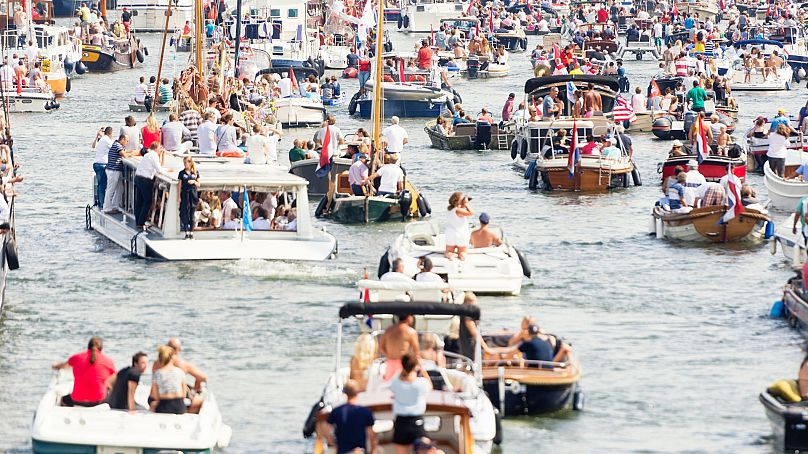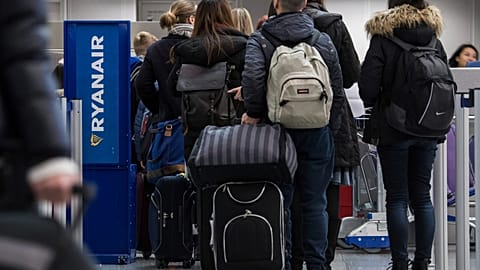From Venice to Amsterdam, bus bans and TikTok influencers are helping reduce tourist numbers.
Europe's ETIAS online travel authorisation has been delayed until 2025.
The requirement restricts travellers from non-EU countries to 30 European nations, including France, Germany, Greece, Italy, Portugal and Spain. Applications will bring in €7 each, adding up to considerable money.
As popular European cities continue to confront the challenges of overtourism in 2024, they choose to move beyond the financial solutions provided by tourist taxes.
These destinations are now deploying unprecedented and innovative strategies aimed not only at managing crowds, but also at preserving their cultural heritage, protecting the environment, and maintaining the quality of life for their residents.
Multiple new anti-tourism measures in Amsterdam
Amsterdam is raising its tourist tax to 12.5 per cent of the accommodation cost in 2024. This means an average €120 room would carry a potential €15 charge per night. Up from the current 7 per cent, that’s the highest rate in Europe. The increase applies to all establishments, from hotels and bed-and-breakfasts to campgrounds.
2024 also means further measures to combat overtourism in Amsterdam. The city banned buses weighing over 7.5 tonnes from entering the city centre, except those granted special exemptions, and increased the tax for cruise ship passengers visiting the city for a day from €8 to €14 per person.
The Netherlands' capital also prohibited opening new B&Bs within certain central districts to help with its increasing housing problem.
Paris imposes unprecedented rise in tourist tax
The tourist tax in Paris increases by 200 per cent in 2024. According to news network France24, the increase is part of the government’s plan to fund enhancements in public transportation.
The city will host the 2024 Olympics from 26 July to 11 August, drawing global attention. Hotels in Paris already raised their rates for the event’s duration. The tax increase will further elevate the cost of staying in Paris. But will it combat overtourism?
Instead of restrictions, limitations and bans, France plans to take a positive approach. “If we want to decongest overcrowded sites, we must bring out other destinations and other tourist routes,” said Olivia Grégoire, the Minister Delegate for SMEs, Trade, Crafts and Tourism of France, in an interview with Le Figaro.
The country is adopting a novel approach to address overtourism in 2024. By engaging social media influencers to highlight less-visited areas, it hopes to decrease interest in more well-known destinations. Understanding the significant influence these individuals wield, the French government is keen on using its extensive networks to direct tourists toward unique, off-the-beaten-path experiences like French eco-lodges or glamping sites.
Venice tightens group tour regulations
As a UNESCO World Heritage Site, Venice still feels the pressure of overtourism despite banning large cruise ships in 2021.
To combat the influx of daily visitors, the Italian city is testing a new access tax for tourists who visit without staying overnight. Each visitor pays €5 per day from 8.30am to 4pm. The city will test this tax for 10 days in May, June and July 2024. Based on the results, the city hopes to implement changes in 2025.
Venice also announced on its official website that it will limit tourist walking groups to 25 people and ban loudspeakers since the latter cause disturbance. It will likely take effect on 1 June, which fits with its Detourism campaign to promote a lesser-known Venice for visitors.
Venice may join Rome and Florence in restricting the number of short-term rental properties, which aligns with broader national efforts in Italy. In June 2023, the Italian Ministry of Tourism unveiled the first draft of a proposed legislation to regulate short-term tourist rentals across Italy, including Airbnb listings.
Daily cap for visitors to Athens' Acropolis
In September 2023, Greece's Minister of Culture Lina Mendoni announced a daily visitor cap of 20,000 for the Acropolis Museum in Athens. The previous average was 23,000 visitors per day. The new programme is on a trial run until 1 April.
It follows the example of many other European locations that introduced daily tourist caps in previous years, like the Louvre in Paris, France; Calanques National Park in Marseille, France; Villa de Balbianello near Lake Como, Italy; or the Old Town in Dubrovnik, Croatia.
Portugal contemplates further actions for non-compliant cruise lines
At the end of December 2023, Carlos Moedas, the Mayor of Lisbon, announced a new tourist tax of €2 per person for all cruise ship passengers, the same fee each guest at a hotel pays.
He added that the income from this tax “will be used to clean the city, to have green spaces and represents a strategy for the future of the city.” The new fees hit on 1 January 2024.
Portugal News reports that the mayor indicated that if cruise operators fail to comply, he is prepared to use his authority to make their entry more challenging. This could mean further measures in 2024, including restrictions on the mobility of their buses.
It aligns with the year-end announcement of the Turismo de Portugal (the Portugal Tourism Board), which placed sustainability and authenticity at the forefront of its 2024 promotion strategy. This approach includes highlighting eco-lodges in Portugal and many other sustainable and authentic travel experiences.
Additionally, they will also utilise TikTok for the first time, aiming to inspire people across multiple channels to explore the diverse regions of Portugal beyond the urban allure of Lisbon.
Dublin is eager to boost its tourist numbers
While certain European cities continue to be popular travel destinations, it’s worth considering other cities that offer equally stunning but less crowded experiences. These alternative destinations provide unique opportunities to explore and enjoy without the challenges of overtourism. They even took measures to attract more tourists in 2024.
In December 2023, Dublin Airport took a significant step toward expanding its capacity to accommodate the growing number of travellers. The airport submitted an application to increase its annual passenger capacity cap from 32 million to 40 million. This move is indicative of Dublin’s expectation to increase the number of visitors to the Emerald Isle.



















